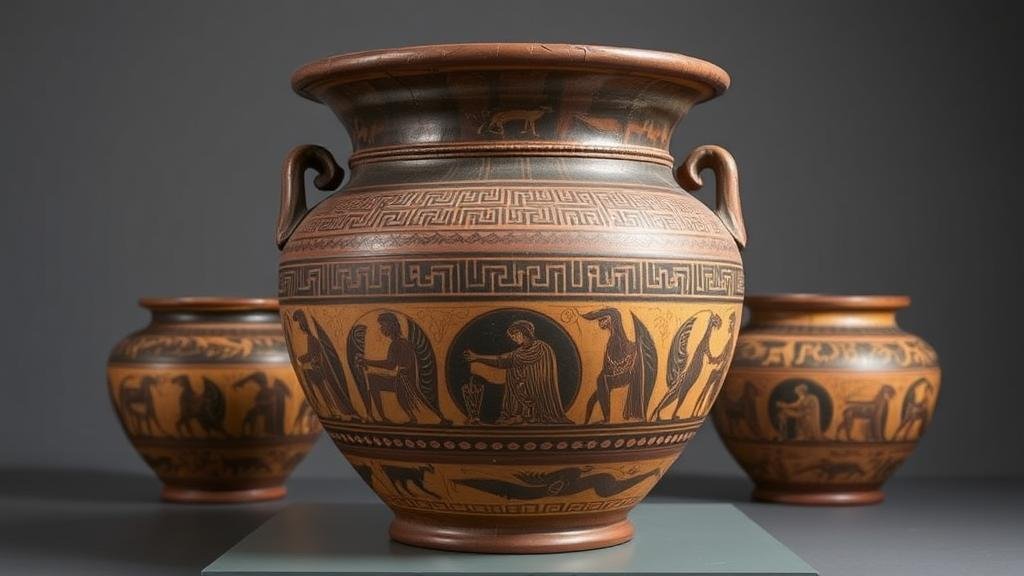Searching for the true identity of the creators of the “Cretan Pithoi,” massive storage vessels from Minoan palaces.
Searching for the True Identity of the Creators of the Cretan Pithoi
The Cretan pithoi are immense storage vessels that were integral to the Minoan civilization, which thrived on the island of Crete from approximately 3000 BCE to 1450 BCE. These massive ceramic containers are emblematic of not only Minoan artistic achievement but also their complex socio-economic structure. But, the true identity of the craftsmen and the specifics of their production remain a tantalizing enigma for historians and archaeologists alike.
The Significance of Pithoi in Minoan Society
Pithoi served multiple purposes in Minoan culture, primarily for the storage of oil, grain, and other bulk products. r considerable size–some reaching up to 2 meters in height–allowed for the storage of large quantities, which was crucial for an economy heavily reliant on trade.
Archaeological findings have revealed that pithoi were often found in significant locations like palaces and storage rooms, indicating their importance in both administrative and domestic contexts. For example, in the palace of Knossos, over 250 pithoi were discovered in what was believed to be a large storage area. This not only reflects the volume of goods stored but also underscores the organizational skills of Minoan society.
Construction Techniques and Artisan Skills
Creating pithoi required advanced ceramic techniques. massive size and decoration of these vessels suggest that skilled artisans were responsible for their production. Most pithoi utilized the coiling method of construction, which involves shaping clay into long strips that are layered to create the desired form. Once formed, the pithoi were often decorated with intricate designs, including geometric patterns and natural motifs, which speak to the artistic capabilities of Minoan craftsmen.
- Pithoi were sometimes up to 1.5 meters wide at the base and approximately 1 meter wide at the top.
- Decorative techniques included the application of paint and the use of various clay types for embellishment.
Historical Context and Identity of the Craftsmen
Despite their significance, the specific identities of the artisans who created pithoi remain largely unidentified. Historical records from the Minoan period are sparse, and inscriptions on pottery primarily reflect religious or administrative matters rather than personal identities.
But, scholars speculate that these craftsmen were likely part of a guild system, where knowledge and techniques were passed down through generations. Such a system would suggest a degree of social organization that allowed for specialization in craft production.
Archaeological Evidence and Theories
The primary evidence for understanding the creators of pithoi comes from archaeological excavations at key sites such as Knossos, Phaistos, and Malia. Recent discoveries have indicated that different regions may have produced pithoi with distinct stylistic features, which could point to regional workshops or specialized artisans.
Also, some researchers argue that the presence of pithoi in trade networks throughout the Mediterranean could imply the existence of master potters whose works were sought after by elite classes or prominent palaces. This raises questions about the potential for social mobility among skilled artisans within Minoan society.
Modern Implications and Conclusion
The mystery surrounding the identity of pithoi creators is not just an academic curiosity; it provides insight into broader themes of craftsmanship, trade, and social organization in ancient civilizations. By studying these storage vessels, we gain valuable understanding of the economic and artistic paradigms of the Minoan culture.
- Ongoing excavations in Crete continue to yield artifacts that may shed light on this mystery.
- Technological advances in pottery analysis, including chemical composition studies, offer potential pathways to identifying different types of clay used across the region.
To wrap up, while the true identities of the makers of the Cretan pithoi may remain hidden, the investigation into their creation contributes significantly to our understanding of ancient Minoan society. Continued research and excavation will hopefully provide more conclusive evidence and deepen our appreciation for these remarkable vessels.



